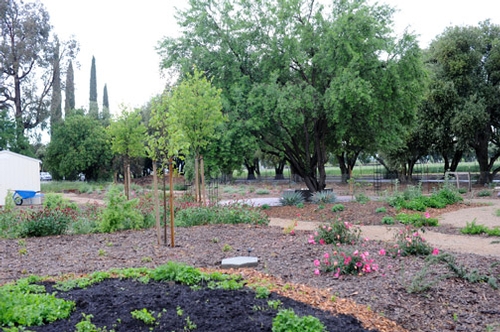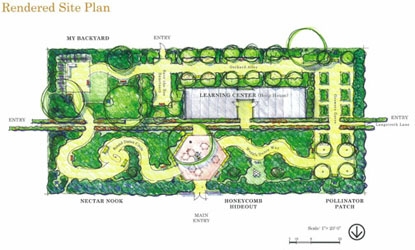Posts Tagged: colony collapse disorder
Marin team designed the Honey Bee Haven
When Jessica Brainard picked up a pint of Häagen-Dazs ice cream at a Sausalito 7-Eleven in 2008, she added a link to a chain of events that culminate tomorrow with the official grand opening of the Häagen-Dazs Honey Bee Haven at UC Davis.
Brainard was featured in a Marin Independent Journal article that detailed how she and three other local landscape designers followed a link on that fateful ice cream carton, leading to their having a substantial role in the creation of the half-acre garden that will raise awareness about the plight of the honey bee.
Interpretative planner Brainard, landscape architect Donald Sibbett, landscape architect Ann F. Baker and exhibit designer Chika Kurotaki won the garden design competition and a year's supply of Häagen-Dazs ice cream. Their winning design plan (pdf) can be viewed online.
The team designed the garden with:
Honeycomb Hideout, a space with large-blossomed plants and an over-sized honey bee sculpture that gives visitors a sense of a garden from a bees-eye point of view Waggle Dance Way, a path on which visitors can meander through a natural landscape Pollinator Patch, full of berries and fruit trees Save-the-Bee Sanctuary, which tells the story of how bees pollinate much of America's food My Backyard Garden, with perennials and a lawn substitute, which illustrate how almost anyone can make a garden bee-friendly Nectar Nook, shows how to create a natural-looking oasis for bees with native and drought-tolerant Mediterranean plants Langstroth Lane, a walkway with a pair of trellises that gives visitors the sense of entering and exiting frames of a bee box "It was really important to give visitors an emotional connection to the plight of honey bees," Brainard told reporter Debbie Arrington. "We wanted them to understand how important they are to our food production and to our life. This garden celebrates that and provides practical examples to promote bee-friendly backyards." The garden, planted last year, already houses a vast diversity of bees, including bumblebees, carpenter bees, leaf cutters, borer bees, mason bees and sweat bees. The grand opening event, free and open to the public, is from 10 a.m. to 2 p.m., Saturday, Sept. 11, at the Harry H. Laidlaw Jr. Honey Bee Research Facility, Bee Biology Road, University of California, Davis. More information is available in a news release by Department of Entomology writer Kathy Keatley Garvey.

The honey bee haven at UC Davis.
Honey bee haven home to 6 million bees
The new Häagen-Dazs Honey Bee Haven at UC Davis will be dedicated Sept. 11, but it is already buzzing with activity, according to a feature that appeared in Saturday's Sacramento Bee.The half-acre refuge is already home to more than 6 million bees representing 55 species, including bumblebees, carpenter bees, leaf cutters, borer bees, mason bees and sweat bees, the article said.
The garden was transformed from a neglected patch of land - described as a giant concrete brick by the program manager - into a bee sanctuary of mostly drought-tolerant, easy-care perennials and shrubs that bloom year round. The compost for the garden came from scraps from campus cafeterias. A giant honey bee sculpture sits on a pedestal decorated with mosaics by schoolchildren, UC Davis students and others.
Interest in bees has grown in recent years due to the insects' well-publicized struggle with colony collapse disorder.
"A lot of people are asking, 'What can I do to help?'" UC Davis entomologist Eric Mussen told Bee reporter Debbie Arrington.
Many California crops are dependent on bees for pollination, such as melons, squash, cucumbers, cranberries, raspberries, strawberries, blueberries, sunflowers, alfalfa, buckwheat, clover and almonds.
"We grow more than 700,000 acres of almonds in California, and every acre needs two to three hives," the story quoted Kathy Garvey of the UC Davis entomology department.
The Häagen-Dazs Honey Bee Haven is open to the public everyday from dawn to dusk. The grand opening is from 10 a.m. to 2 p.m. Sept. 11. For more information and directions to the haven, see the Häagen-Dazs Honey Bee Haven website.

The bee sculpture in the Häagen-Dazs Honey Bee Haven at UC Davis.
Be kind to honey bees
A national roundup of honey bee happenings on the website Tonic.com touched on the UC Davis Honey Bee Haven, a bee-friendly garden set to open to the public Sept. 11.
Tonic reports on good things that happen, dwelling on stories that "inspire, bring hope or simply put a smile on your face." And what could be more inspirational than a lovely flowering garden made possible by a generous donor that daily brings delight and joy to the world, Häagen Dazs ice cream?The Honey Bee Haven is designed to encourage public awareness of the modern-day plight of the honey bee, which Tonic reporter Liz Corcoran described even though it is perplexing and sad. In recent years, bees have been subject to a mysterious decline called Colony Collapse Disorder. Factors that scientists suspect cause CCD include pests, pesticides, malnutrition and stress from transport.
Häagen Dazs - recognizing that fruit, nut and honey ice cream ingredients are dependent on bees - launched the Häagen Dazs Loves Honeybees campaign and donated half a million dollars to Penn State and UC Davis for honeybee research and awareness programs.
Here are some ways to be kind to bees shared in the Tonic story:
- Adopt a beehive, offered by the British Beekeeping Association for about $50 a year
- Support reinstatement of the Boy Scout beekeeping merit badge, which was discontinued in 1995
- Plant sunflowers, hollyhocks, foxgloves and flowering herbs, and if you have room, fruit trees, buddleia and hebe
- Forego the use of herbicides and pesticides.

An artist's rendering of the Honey Bee Haven.
Farm advisor hails self-pollinating almond
A self-pollinating almond variety under study at the USDA's research facility in Parlier would relieve farmers of costly annual bee rental to pollinate their trees, according to an article in Saturday's Fresno Bee.
"That is like the Holy Grail," UC Cooperative Extension farm advisor Roger Duncan told Bee reporter Robert Rodriguez.
"You can feel that hairiness with your tongue," the release quoted USDA geneticist Craig Ledbetter. “That can turn off U.S. almond consumers, who are used to the smooth texture of Nonpareils."
Ledbetter used Tuono as the male parent in conventional hybridizations with California almond cultivars and selections. In 2008, he brought eight promising self-pollinating selections to the California Almond Board for evaluation of taste and appearance. Testers rated the nuts comparable to Nonpareils, the USDA release said.
ABC Action News in Fresno also took on the story. It said Ledbetter began his work with self-pollinating almond trees 17 years ago out of fears Africanized bees could kill off local hives.
"It was out of those concerns we really started the program," Ledbetter told reporter Dale Yurong. "It's ironic that a different bee problem (Colony Collapse Disorder) came up."

Bee hives in a California almond orchard.
Plight of the honeybee particularly bad in 2010
After several mild years, colony collapse disorder of honeybees has returned with a vengeance in 2010, according to news articles that ran over the weekend.
Fresno Bee reporter Robert Rodriguez used UC Davis apiculturist Eric Mussen as a source for his story, describing the scientist as "the state's leading bee expert."
"It never went away," Mussen said about the mysterious disappearance of bees from hives, "but this year a substantial number of beekeepers got walloped again. And worse than they had been hit before."
Another concern is this year's unusually cool, wet winter. In Merced County, farmers have already had to apply fungicides to combat such problems as bloom rot.
"There some growers who are applying their third spray, when normally this time of year they may only make two," the article quoted David Doll, a UC Cooperative Extension farm advisor in Merced County.
The Hanford Sentinel ran a story about rising cost of honeybees to farmers, which it blamed on CCD and growing almond acreage. The Woodland Daily Democrat's article contained comments about pollination from UCCE farm advisor Joe Connell of Butte County.
Connell said it appears the majority of Northern California growers had their pollination needs met this year."There is definitely potential for a good harvest, but we won't know for sure until the nuts themselves start to size up," Connell said. "Definite answers probably won't be available until the end of March."
The Democrat story said Mussen and Connell believe cold weather and high rainfall during this year's almond blossom season reduced the amount of time the bees could spend in the fields, and might cause the ripening almonds to drop from the trees before they are fully developed.
"Proper pollination and fertilization will allow the nut to fasten (to the tree) and really hold a big crop," Mussen told reporter James Noonan.
Despite these challenges, Connell was hopeful about the 2010 almond season.
"We have a good number of blossoms right now," Connell was quoted, "if we can get nuts to take hold in about a quarter of them we'll be in pretty good shape."

A pollen-covered honeybee on an almond blossom. (Photo by Kathy Keatley Garvey.)
